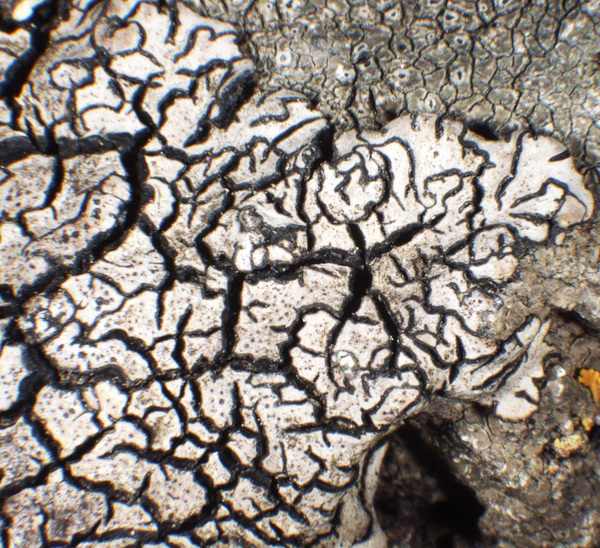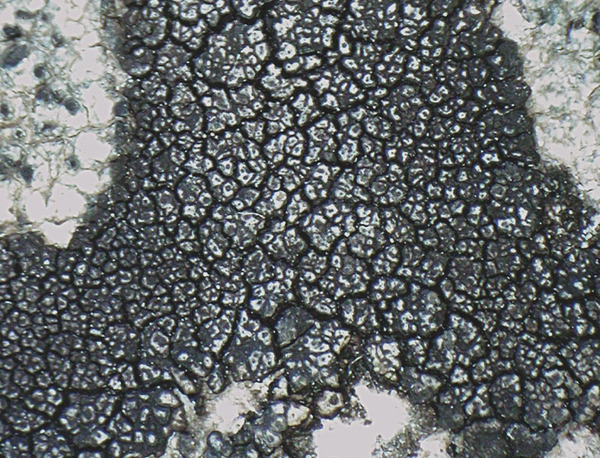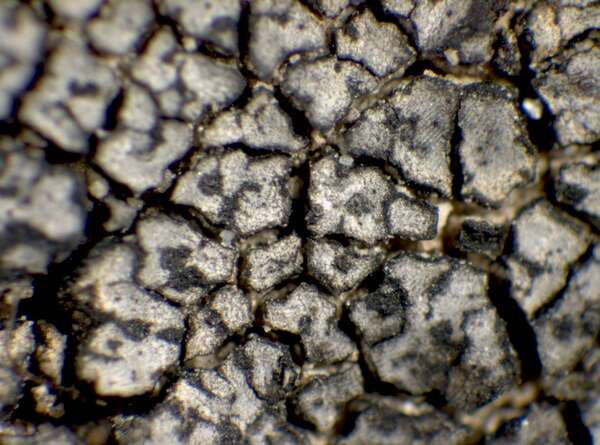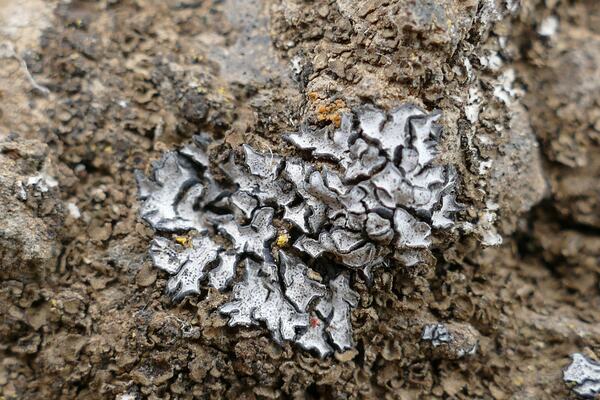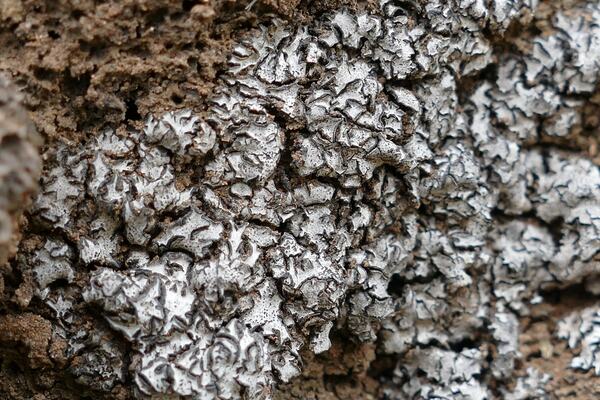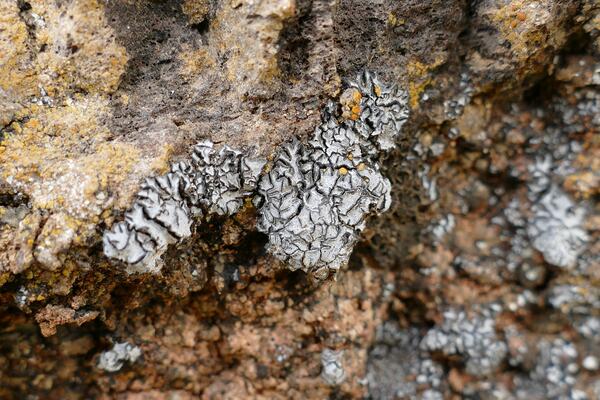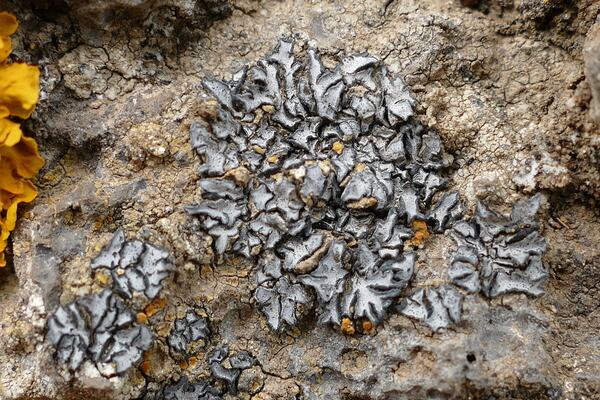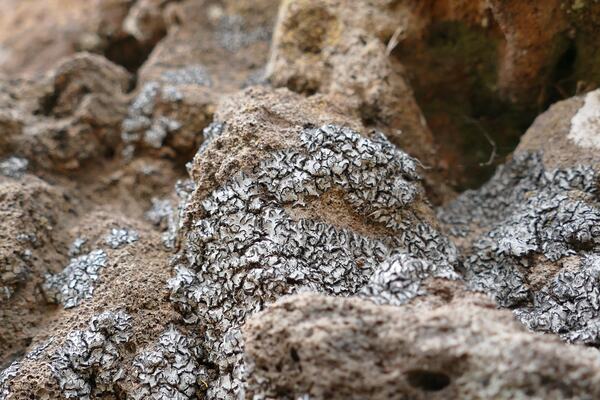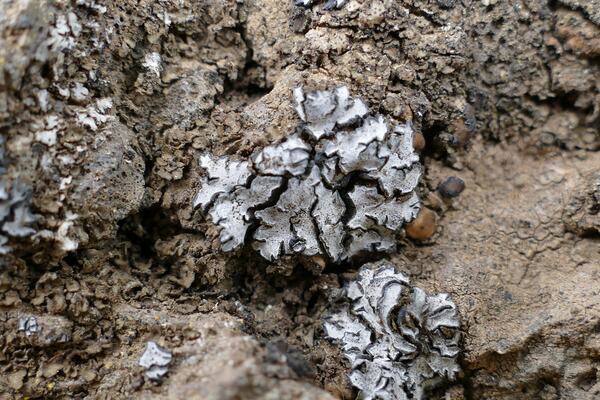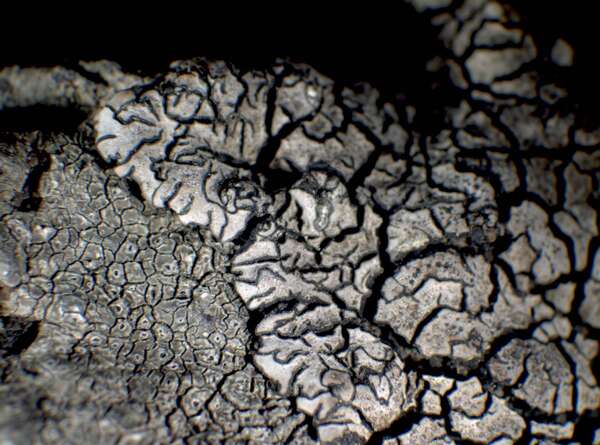Placopyrenium bucekii (Nádv. & Servít) Breuss
in Nimis & Poelt, Studia Geobot., 7, suppl. 1: 182, 1987. Basionym: Dermatocarpon bucekii Nádv. & Servít - Beih. Bot. Centralbl., 55 b: 267, 1936.
Synonyms: Placidium steineri Wettst.
Distribution: N - Lig (Breuss 2009). C - Tosc (Breuss 2009), Laz (Tretiach 2004), Sar (Breuss 2009, Nascimbene & al. 2023). S - Pugl (Nimis & Tretiach 1999), Bas, Cal (Puntillo 1996, Breuss 2009), Si (Nimis & al. 1996b, Grillo 1998, Grillo & Caniglia 2004, Iacolino & Ottonello 2006).
Description: Thallus crustose, most often placodioid, well-developed, episubstratic, areolate-subsquamulose, pale grey and whitish-pruinose when dry, brownish when wet, forming several cm wide patches (rarely >10 cm), the areoles slightly concave to flat, constricted at base, with conspicuous black sides and a black lower surface, the central ones (formed only in old thalli) rectangular or polygonal, 0.3-2.6 x 0.2-1.6 mm, the peripheral ones lobed, elongate, irregularly radiating, (1-)1.5-3(-4) x 0.3-1(-2) mm, often loosely attached and overlapping. Upper cortex up to 40 µm thick, poorly differentiated, paraplectenchymatous, of angular cells arranged in vertical rows, with thin, brown-pigmented walls, overlain by a 3-9 µm thick epinecral layer; photobiont layer of vertically arranged columns of algal cells, 80-250(-500) μm thick; lower cortex of irregularly arranged, rounded cells with 0.5-2 μm thick, dark brown walls. Perithecia immersed in the central areoles, up to 10 per areole, visible from above as 0.1-0.2 mm wide, black dots. Involucrellum absent or rudimentary and lid-like above the ostiole; exciple brown and 30-50(-80) μm thick in upper part, colourless and 20-30 μm thick in lower part, paraplectenchymatous; periphyses well-visible around the ostiole, 30-40 x 1-3 μm; paraphyses degenerating early, usually not visible; hymenial gel hemiamyloid, I+ red (I+ blue at very low concentrations of I), K/I+ blue. Asci 8-spored, clavate, I-, fissitunicate, the wall thickened above with an indistinct ocular chamber, Verrucaria-type. Ascospores 0-1-septate, hyaline, ellipsoid to subfusiform, 11.5-17.5 x 4-7.5 μm, with a very thin perispore. Pycnidia immersed, multilocular, Dermatocarpon-type. Conidia bacilliform, (3-)3.5-5.5(-9) x l-l.5 μm. Photobiont chlorococcoid. Spot tests: cortex and medulla K-, C-, KC-, P-, UV-. Chemistry: without lichen substances.Note: a mainly Mediterranean lichen with outposts in dry-warm temperate areas, found on base-rich siliceous rocks, exceptionally on limestone and sometimes even on soil, often occurring together with Peltula euploca, but with a different ecology, being most common on dust-impregnated faces. It should be looked for in suitable habitats of the Alps, especially in dry-warm situations. For a very detailed description see Menard & Roux (1995).
Growth form: Crustose
Substrata: rocks
Photobiont: green algae other than Trentepohlia
Reproductive strategy: mainly sexual
On otherwise dry surfaces with short periods of water seepage after rain
Commonnes-rarity: (info)
Alpine belt: absent
Subalpine belt: absent
Oromediterranean belt: absent
Montane belt: absent
Submediterranean belt: very rare
Padanian area: absent
Humid submediterranean belt: very rare
Humid mediterranean belt: rather rare
Dry mediterranean belt: rather rare
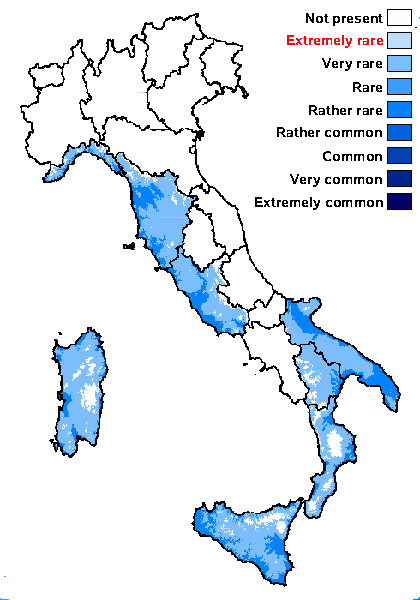
Predictive model
Herbarium samples
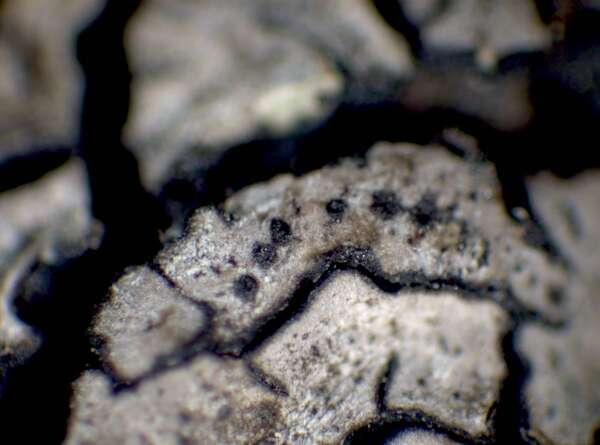

P.L. Nimis; Owner: Department of Life Sciences, University of Trieste
Herbarium: TSB (12744)
2001/11/28
detail of areole with perithecia
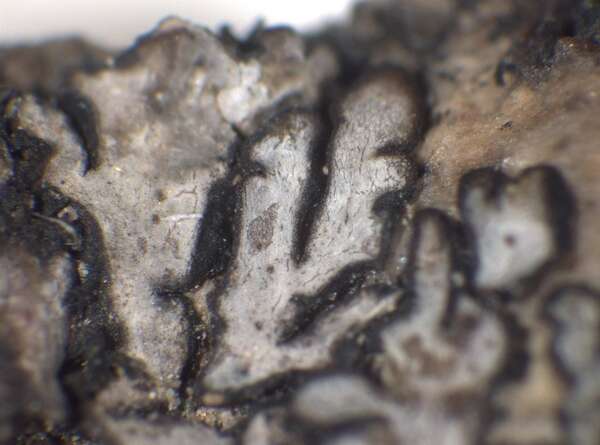

P.L. Nimis; Owner: Department of Life Sciences, University of Trieste
Herbarium: TSB (10467)
2003/03/12


P.L. Nimis; Owner: Department of Life Sciences, University of Trieste
Herbarium: TSB (12744)
2003/03/12
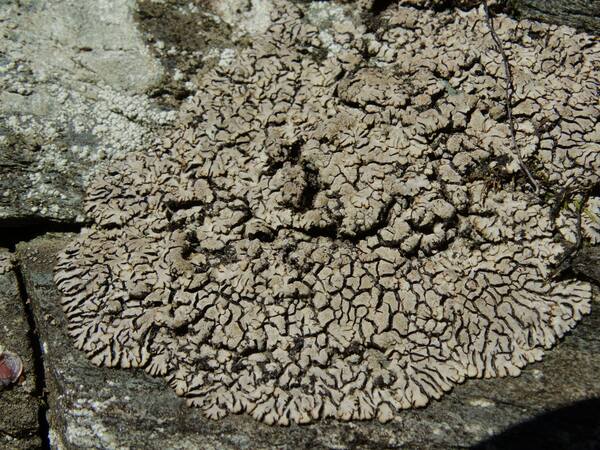

Domenico Puntillo; Owner: Department of Life Sciences, University of Trieste
Italy, Calabria, Cosenza, Valle del Fiume Arente (Castiglione Cosentino, CS); altitude: 213 m
21/02/2017
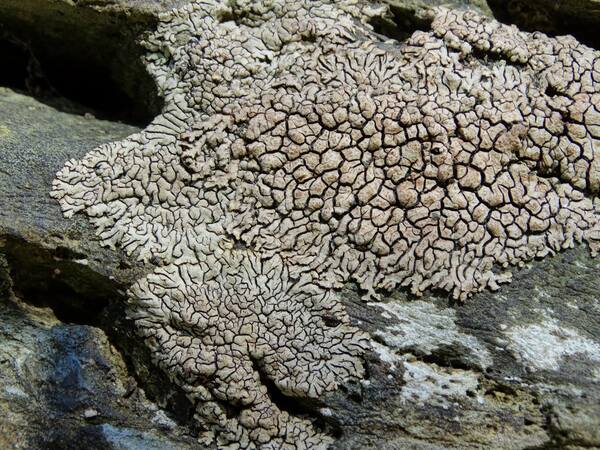

Domenico Puntillo; Owner: Department of Life Sciences, University of Trieste
Italy, Calabria, Cosenza, Valle del Fiume Arente (Castiglione Cosentino, CS); altitude: 213 m
21/02/2017


Domenico Puntillo; Owner: Department of Life Sciences, University of Trieste
Italy, Calabria, Cosenza, Valle del Fiume Arente (Castiglione Cosentino, CS); altitude: 213 m
21/02/2017
Growth form: Crustose
Substrata: rocks
Photobiont: green algae other than Trentepohlia
Reproductive strategy: mainly sexual
On otherwise dry surfaces with short periods of water seepage after rain
Commonnes-rarity: (info)
Alpine belt: absent
Subalpine belt: absent
Oromediterranean belt: absent
Montane belt: absent
Submediterranean belt: very rare
Padanian area: absent
Humid submediterranean belt: very rare
Humid mediterranean belt: rather rare
Dry mediterranean belt: rather rare

Predictive model
| Herbarium samples |


P.L. Nimis; Owner: Department of Life Sciences, University of Trieste
Herbarium: TSB (12744)
2001/11/28
detail of areole with perithecia


P.L. Nimis; Owner: Department of Life Sciences, University of Trieste
Herbarium: TSB (10467)
2003/03/12


P.L. Nimis; Owner: Department of Life Sciences, University of Trieste
Herbarium: TSB (12744)
2003/03/12


Domenico Puntillo; Owner: Department of Life Sciences, University of Trieste
Italy, Calabria, Cosenza, Valle del Fiume Arente (Castiglione Cosentino, CS); altitude: 213 m
21/02/2017


Domenico Puntillo; Owner: Department of Life Sciences, University of Trieste
Italy, Calabria, Cosenza, Valle del Fiume Arente (Castiglione Cosentino, CS); altitude: 213 m
21/02/2017


 INDEX FUNGORUM
INDEX FUNGORUM
 GBIF
GBIF
